Japan dominated the sportbike industry for decades. The onslaught began with the lightweight two-strokes of the 1960s and continued until the economic downturn forced Honda, Kawasaki, Suzuki and Yamaha to slam on the brakes just a few years ago. Meanwhile, European companies such as Aprilia, BMW, Ducati and MV Agusta have rolled the throttle to the stop and arguably moved into the lead, in terms of technology if not volume. Some say Japan, Inc.’s high-water mark is behind us, but the tide of progress hasn’t stopped rising; it’s just slowed.
The Big Four are still churning out some very impressive sportbikes. In the midst of this worldwide depression we had two “Class of” winners emerge from Japan: Honda’s CBR1000RR in 2008 and Yamaha’s YZF-R1 one year later. For 2012, both bikes are back, the Honda updated with new suspension and wheels while Yamaha makes the technological leap to traction control. These optimized former champs face off against Suzuki’s updated GSX-R1000 and the new-for-2011 Kawasaki ZX-10R.
If we were to include every competitive model in the 1000cc-and-up superbike class, we would have no fewer than eight bikes. Rather than exhaust ourselves with a battle royale, we opted to test the European and Japanese machines separately. Besides, our annual “Class of” comparison is hands-down the best week of the year, so why not enjoy it twice? To determine an overall victor, we’ll take the winner from each group and pit them against each other in a future issue.
Talk about splitting hairs: These four Japanese superbikes’ specifications barely vary. Displacement and bore/stroke are practically interchangeable, as are price, power and chassis geometry—these are essentially four manufacturers’ take on the same machine. The big difference is in electronics, or lack thereof. The ZX-10R and YZF-R1 have joined the technological revolution, but are the non-digital CBR and GSX-R stuck in the Stone Age? Or worse yet: Are the good, old days of the all-conquering Japanese literbike over? It was our mission to find out.
Our testing regimen entailed two days of road riding and two days at the racetrack. We droned down the congested 405 Freeway, raced along the serpentine Ortega Highway and did repeat runs up and down State Route 243 above Banning, California. From there we headed to Chuckwalla Valley Raceway in Desert Center for two days of performance testing, then reversed our route for the ride home. The goal of our four-day adventure was simple: To determine which bike from the Land of the Rising Sun would rise to the top.
Honda certainly thinks so, which is why engineers didn’t feel the need to add traction control or make any major changes to the model for its 20th anniversary. Updates include new wheels and suspension, a restyled fairing, a new digital dash and a few fueling tweaks. Aside from that it’s the same bike, although emissions requirements and associated equipment have robbed it of 3.5 bhp and 2 lb.-ft. of torque and added 5 lbs. compared to the last example we tested.
Even so, the CBR feels lightest and most powerful on the street, earning high praise from all of our testers. Compact and narrow between your knees, it looks downright diminutive next to the chunky Yamaha. The Honda’s smaller size finds you up on top of the bike rather than down in it, which is excellent for attacking corners and a characteristic that made it the favorite of our smaller testers. The CBR makes the most peak torque, spreads it on thickest and boasts more midrange horsepower than the others. Combine that with shorter final gearing and the Honda feels significantly more powerful than its competitors at low rpm, making it more fun to ride on the street and rabid on the racetrack.
Fueling is precise and smooth at higher revs and larger throttle openings, but we noticed some abruptness at lower engine speeds and smaller throttle openings, despite injection adjustments intended to address just that. Shifting isn’t as clean as on the Yamaha or Suzuki, but the extra midrange grunt means you don’t have to shift as often.
The Honda has the plushest seat, but its high, non-adjustable footpegs cramped our taller testers’ legs and a pronounced buzz in the pegs and grips annoyed all of us on our street ride. The CBR’s compact size is a benefit while sport riding, but that small fairing provides the least wind protection, resulting in buffeting on the freeway. If you’re tall and your commute entails a lot of superslab, the Honda might not be the best option. If you’re shorter, it may be the perfect fit.
The CBR’s celebratory 20th anniversary color combination is attractive and helps distinguish the bike from earlier models, but we were disappointed to find that the red and blue graphics are stickers rather than paint. Initial impressions of the Honda’s new LCD dash were good—it looks modern compared to the GSX-R's and R1's displays—but the more we rode the bike, the less we liked the new setup. It catches a lot of glare and is difficult to read in sunlight, and the small, dim shift lights are essentially useless.
And on the track, the Honda’s robust midrange made it the quickest to spin the rear tire, keeping everyone on their toes and causing one TC-reliant tester to back off. If you could manage the wheelspin, the CBR got incredible drive off of corners, but riding the bike at that level proved mentally and physically exhausting. Below race pace, the Honda was actually the easiest to ride due to its 600-like handling and linear literbike power. The back end felt lower than we remember—perhaps due to the new Balance-Free rear suspension—and the “captured” shock has no provision for ride-height adjustment. Even so, the CBR had the lightest steering and felt unshakably stable, with the best front-to-rear suspension balance. Support from the new Showa Big Piston Fork was superb and enabled hard, late braking, but the Tokico brakes faded as our test progressed, resulting in inconsistent performance during our timed sessions. Even with that handicap, the Honda clicked off the second-quickest lap time, proving it’s still competent and relevant.
Honda’s time-tested design makes the CBR1000RR the most transparent bike here, but familiarity breeds contempt. It’s got fresh styling and the new suspension certainly improves performance, but in four years Honda has only taken a small step forward, whereas Kawasaki and Yamaha have made huge strides. The CBR1000RR is still a contender, but it’s no class king.
OFF THE RECORD
Everyone dug the big Ninja, but its peaky power and awkward looks scared me! The GSX-R is as fun as ever to ride and worked really well at the track, but we all agreed that it's overdue for a redo. C'mon, Suzuki! The R1 is character-rich and seriously stylish, but I couldn't live with that engine heat and it was pretty disappointing at the track. It's heavy and isn't particularly powerful. Fresh looks and that same great engine made the CBR my favorite. It was the easiest of this litter to turn-in, letting me tighten up my line anywhere, and the new Balance-Free suspension provided superb rear-end feel driving off turns. Who needs traction control when a bike is this good?
Kawasaki’s ZX-10R underwent a complete overhaul in 2011, and while nothing is new for 2012, the Ninja still stands out as the most modern and sophisticated machine here. It’s also the lightest and most powerful, weighing in at just 440 lbs. wet and producing 157.9 bhp at 11,600 rpm. Kawasaki was the first Japanese manufacturer to outfit a sportbike with traction control, and the S-KTRC (Sport-Kawasaki Traction Control) package lets you get on the gas harder and sooner, with obvious benefits. The system provides three levels of intervention and there are also three power modes (Full, Medium and Low), but we never felt the desire to toggle away from the full monty.
The ZX-10R's ergonomics are odd but agreeable. The bike is long and low, with wide-set clip-ons and a high seat. It’s a fairly roomy cockpit, with excellent wind protection and ample legroom once the adjustable rearsets were put in the lower position. The mirrors are the best of the bunch—in fact, the best we’ve experienced on a modern sportbike—and provide a panoramic rearview that’s un- affected by engine vibration. The multi-color LED tachometer that spans the top of the dash makes you feel like a spaceship pilot and conveys engine speed nearly as well as an analog unit, but some testers found the amber glow distracting, as if the engine warning light were on.
The ZX-10R feels like a baby ZX-14R on the freeway: big, stable, smooth and stinking-fast when you got up in the revs. Opening this one up really feels like you’re pulling the trigger on something powerful, which wasn’t an impression the other bikes conveyed. It’s got a muted-but-appealing exhaust note and the kind of midrange power and subdued engine vibration that make you forget which gear you’re in. Push the tachometer past 9000 rpm, however, and the ZX-10R tries to rip your arms off! The Kawasaki was noticeably faster on Chuckwalla’s short straights, and it has mega-brakes that are a step above the rest in terms of feel and power.
The ZX-10R rolls off the assembly line with the rear end slammed for stability, which results in some wonky handling for those of us who prefer canyon roads over the HOV lane. As delivered, the bike was slow to steer and wanted to stand up and run wide in turns, requiring constant bar input to stay on line. Kawasaki’s ace technician Joey Lombardo transformed the Ninja’s handing by shimming the shock to add 8mm of rear ride height. Steering effort was thus reduced and the tendency to run wide eliminated. As the pace quickened at the track, front-end chatter and headshake became a problem, but Lombardo fixed those issues by raising the front end 4mm and tweaking spring preload. Those changes slowed steering again, but stabilized the front. We felt the most confident upping entry speeds on the ZX-10R, as evidenced by the Bridgestone techs’ highest recorded front-tire temperature of 174 degrees. In the end, the Kawasaki turned the fastest lap at the racetrack, clicking off a 1:53.13—exactly 1 second quicker than the runner-up Honda— with much less effort or drama.
Non-digital bikes might be more exhilarating to ride at the edge of adhesion, but TC lets you do it with less strain and risk. There’s no doubt that the Kawasaki’s S-KTRC enabled quicker lap times, but we’d like to see more refined intervention levels; or better yet, more of them. Level I proved too lax, letting the rear tire step out so quickly that instinct kicked in before the TC, negating the “no worries” aspect of electronics. Level II proved more effective, cutting in early enough to keep the back tire in line while allowing aggressive throttle application. But even in Level II, riders still experienced some frightening moments when drive slides became lateral slides. In that situation, there’s nothing electronics can do for you.
The Kawasaki’s gear changes could be smoother and the chassis took a lot of work to set up, but once we got it working, it worked the best—by a long shot. The ZX-10R was the easiest to go fast on thanks to its stable handling, mega-power, boss brakes and the assistance of S-KTRC. The Ninja feels, powerful and well put-together, with a look that’s both edgy and distinctly Kawasaki.
OFF THE RECORD
These bikes are so similar that it had to come down to the details. The Kawasaki serves up raw power with an impressive traction-control system. It might have handled slow and felt low on the street, but it came into its element at the track. I went fastest on the Suzuki due to its stability and the confidence it inspired, but it's loud and looks and feels unrefined compared to the competition. The Honda is precise and nimble, and I think it had the best front-end feedback. The lack of TC didn't bother me, but the high footpegs did. If not for the limited legroom, the CBR would have been my pick for the street. The Yamaha has the best TC and a great motor, but the harsh throttle response and underseat "birth-control pipes" overshadow any positive aspects. I'm going with the Kawasaki.
Like Honda, Suzuki hasn’t done much with its big-dog GSX-R1000 in recent years. Redesigned in 2009, Suzuki’s engineers saw fit to revisit the Gixxer Thou for 2012 and revise a few things to enhance usability. The engine sports lighter, high-compression pistons and revised cam timing for improved midrange power, while removing a muffler and switching from Tokico to Brembo brake calipers cut 4 lbs. and helped differentiate this GSX-R from previous models.
In this era of compact, mass-centralized sportbikes, the Suzuki feels big compared to everything except the Yamaha. The GSX-R is narrow at the waist but has a wide engine and flared fuel tank that force your legs out. Even so, all of our testers found it relatively comfortable, some even rating it best. Softer springs and milder damping helped the suspension absorb most everything the choppy freeway and frost-heaved mountain roads threw at it. The GSX-R was delivered with its footpegs in the highest position, and they remained there throughout our street ride since legroom was sufficient. The seat is hard but easy to move around on in the twisties, and while the cockpit is roomy the landscape is nothing to get excited about. The dash looks dated and rather Toys-R-Us, while the unfinished inner fairing and flimsy bodywork give the bike a cheap appearance, especially next to refined machines like the Honda and Kawasaki.
Engine improvements aren’t as apparent from the seat as the dyno sheet would suggest. The Suzuki rivals the Honda for midrange power, yet it feels the weakest down low. The previous model’s flat spot between 6000 and 7000 rpm has been successfully filled in, but there isn’t much poke until you spin it above 8000 rpm. This bike would benefit most from shorter final gearing. The Suzuki’s peak output of 155.2 bhp at 11,800 rpm is right on the heels of the Kawasaki’s, but it takes revs to unlock that power and tall gearing means you really can’t let the Gixxer breath on public roads without obliterating the speed limit. Fueling is precise and utterly flawless, and the handling is likewise faultless, but on twisty roads the doggy low-end performance made the Suzuki less exciting to ride. Add to that a vacuum-like intake noise, itinerant engine vibes, blurry mirrors and exhaust heat that irritates your left foot and it’s easy to see why the GSX-R1000 didn’t rate well as a streetbike.
But the Suzuki came alive at the racetrack, where its quick and predictable handling and strong top-end power helped it put down a lap time of 1:54.33 with relative ease. If kept on the boil, the Suzuki is quick and less likely to spin the rear tire than the Honda, but doesn’t come off corners nearly as hard. Suspension setup and handling proved excellent right away, with a high level of stability and the most neutral behavior while trail-braking. The GSX-R received high ratings on front-end feedback, and everyone appreciated how well it cornered. With the most aggressive steering geometry and shortest wheelbase it’s no surprise it turned the easiest and was the quickest to transition from vertical to leaned over and back again.
The Suzuki also received unanimous praise for its seamless SDTV (Suzuki Dual Throttle Valve) fueling, which has nary a hiccup or hesitation to interrupt a feeling of total connectivity between your right wrist, the engine and the rear tire’s contact patch. The smooth fueling lets you get on the gas early and pour it on in complete confidence. And while the Suzuki’s dash looked silly on the street, that big, analog tachometer and those bright shift lights work wonderfully at the track. The new Brembo brakes are adequate, but not outstanding. Stopping power was good but feel was lacking, which kept testers from comfortably increasing entry speeds.
The Suzuki is old-school and somewhat dated, but it still works amazingly well, and its few performance problems are easily remedied. Unfortunately, it’s not substantially better than it was three years ago. It’s louder and rougher around the edges than the others, and call us shallow, but it just doesn’t look new enough. We docked it style points because the 2012 version is so indistinguishable from previous years and other models in the GSX-R family. Yet Suzuki is selling a ton of them, thanks in part to zero percent financing, which in this economy is pretty enticing. Combine that with the GSX-R’s proven track record in AMA Superbike and club roadracing, and it’s easy to understand why track-day riders and racers still choose to own one.
OFF THE RECORD
I'm a big fan of small bikes, and the Honda gave the impression of being a smaller machine with good midrange power. I got a kick out of spinning the rear tire off corners, but then its brakes went off. I was impressed with the Suzuki's handling and engine, but it was uninspiring unless I was hoisting 100-mph wheelies. The Yamaha rocked as a streetbike, but as soon as the mercury started to rise, everyone wanted off that heat sink! The Kawasaki felt as long as a limo until we got the suspension sorted. I liked the low-slung riding position and who can deny that engine, especially when you can have 170 bhp with a simple ECU reflash? For my money, I'd go with the ZX-10R.
In this crowd of essentially identical motorcycles, the YZF-R1 stands apart. Kudos to Yamaha for providing riders with a bike that so clearly utilizes trickle-down technology from MotoGP racing. First the YZF-R1 was blessed with the Crossplane crankshaft, a design that was proven by Valentino Rossi in 2004 and then applied to the streetbike in 2009. For 2012 the R1 received traction control, blessing street riders with an electronic rider aid that was developed at the world championship level. This latest version also has a restyled nose, with sharper features and LED illumination along the lower edges of the air intakes.
All of our test riders were fond of the R1 early on. Its rider triangle is spacious with high, flat clip-ons that are easy on your wrists. It’s comfortable for a sportbike, with compliant suspension and comprehensive wind protection that’s closer to that of an FJR1300 than an R6. Then there’s the addictive engine character that made the Yamaha a favorite on the street. Twist the throttle in any gear and the Crossplane engine grunts and slingshots you forward with locomotive-like power. Some testers found the throbbing low-rev crank vibration annoying, while others considered it an asset. Where the other bikes in this comparison felt and sounded like a fleet of sewing machines, the R1’s deep, pulsing exhaust note and distinct engine character set it apart.
With more seat time, however, testers started voicing complaints. The R1 has the strongest engine braking and light-switch throttle response, which makes navigating tight roads nerve-wracking. It also throws off a lot of engine and exhaust heat, cooking your legs and backside. And then there’s its size: With a full fuel tank the Yamaha tips the scales at 475 lbs.—35 lbs. heavier than the Kawasaki—and you can feel that weight every time you bend the bike into a turn. It’s also the least muscular, putting down “only” 146.8 bhp at 12,000 rpm. The Yamaha’s apparent size is exacerbated by a fairing that is half again wider than the Honda’s, and even with reshaped muffler caps and heat shields intended to reduce its perceived bulk, the R1’s posterior still warrants a “wide load” banner. All that aside, the Yamaha is a great streetbike, with all the character and style you want and stable (albeit sluggish) handling. Next to the Honda the Yamaha feels strongest down low, and shift action is so sweet, we’re convinced its crankcase is filled with honey.
At the racetrack the R1’s heft was a hindrance, as was the initial chassis setup. The bike had a tendency to stand up under trail-braking, making graceful corner entrances challenging. It also ate front tires. Raising the front end made the Yamaha more neutral at corner entry and slowed tire wear, but it was still more work to bend into corners than the others.
The R1’s abrupt throttle response was annoying on the street, but proved maddening at the track while trying to dial on the gas at full lean. Even in the “Standard” power mode, throttle response off closed throttle was jerky, upsetting the otherwise stable chassis. Switching to the softer “B” power mode blunted performance too much, and we can’t imagine where or when anyone would ever use the ultra-severe “A” mode. The Yamaha’s big six-piston Sumitomo brake calipers work well, but the slipper clutch didn’t slip enough, causing some unnecessarily lurid slides entering tighter corners.
The Yamaha’s Traction Control System (TCS) proved the better of the two systems here. It offers more levels of sensitivity and has a smoother engagement strategy that manipulates the ride-by-wire throttle butterflies first, rather than cutting spark and then fuel like the Kawasaki. The Yamaha was already a smooth spinner, and with traction control we were able to confidently streak every corner exit on the track. Even so, the R1’s impediments made it difficult to ride fast, resulting in the slowest lap times.
We can’t say enough about how smoothly the Crossplane engine puts down power, but while the other bikes’ output ramps up at high rpm, the R1’s falls off. It still has the most inspiring exhaust sound and outstanding engine character, but that’s not enough to compensate for the searing engine heat, extra heft and abrupt throttle response. The YZF-R1 incorporates some impressive technology, but overall it doesn’t work well as a package.
OFF THE RECORD
I loved our "Class of 2008"-winning Honda CBR1000RR so much that I bought one. Minor improvements make this year's model even better, and I fell in love all over again on Highway 243. Light, impeccably balanced and absolutely neutral, it was the perfect mount—until we arrived at the track. Once the CBR's rear tire started spinning, I folded. On the TC-equipped bikes, however, I was all in. The difference between my times on the TC and non-TC bikes was vast. Traction control boosts my confidence and my ability to concentrate on other aspects of going fast. The Yamaha delivers better TC, but that's all. The Ninja rules everywhere else. Honda and Suzuki: It's time to step up.
When we embarked on this comparison, we suspected we were going to have a hard time making distinctions between these four bikes. Seat time cleared up that concern, and by the fifth fill-up one bike was already pulling into the lead.
We’re huge fans of the Honda CBR1000RR’s engine and 600-like handling, but restrictive ergos limit its appeal to smaller riders, and that midrange-rich engine makes it a handful at the racetrack. It still hauled ass, but it would be even faster with traction control and fresh brakes.
The Yamaha YZF-R1 is charismatic and impressive in its own right—not to mention unique. But it’s also the only bike with real problems—namely abrupt throttle response, torturous engine heat and a portly build that makes for sluggish handling.
We weren’t expecting much from the Suzuki GSX-R1000, but this old-school design still works, especially at the racetrack. With shorter gearing it would be an even better streetbike, but there’s no denying that the Gixxer has fallen behind the times and is past due for a comprehensive redesign.
The only bike we couldn’t nit-pick was the Kawasaki ZX-10R. It feels the most refined and sophisticated, and proved the easiest to go fast on once we got the chassis sorted. Kawasaki has made the biggest investment in recent years, and it’s paid off. Riders want progress, and the ZX-10R delivers—as a streetbike and as a track tool.
Team Green isn’t in the clear yet, though. The ZX-10R’s victory here only assures pole position amongst its countrymen; it still has to face off against the winning European bike. Will the Ninja battle the Aprilia RSV4 Factory APRC, BMW S1000RR, Ducati 1199 Panigale or MV Agusta F4RR Corsacorta? Check back next month to find out… MC
Bridgestone R10 Tires
Up To The Task
Words: Ari Henning
Photo: Adam Campbell
You never want traction to be the limiting factor in a comparison test. So rather than slide around Chuckwalla Valley Raceway on stock street tires, we outfitted all four testbikes with Bridgestone’s latest DOT-approved R10 racing buns. Rory O’Neill from Performance Tire Service in Indianapolis and Brian Davenport from Bridgestone Americas in Nashville served as bead-breakers over the course of our two track days, and kept us rolling on fresh rubber that was always at the right temperature and inflated to the proper pressures.
The R10s are the successors to the BT003s we used during our “Class of ’09” comparo, and have undergone a few key developments aimed at improving grip and handling. A new tread pattern is the most obvious change. The R10s now feature a unique “3D” groove design that’s said to enhance stability and feel entering and exiting corners and aid in quick warm-up and rider feedback. An optimized crown profile with a steeper peak and flatter shoulders helps quicken steering and puts more rubber on the road at full lean.
The R10s also use new, more versatile rubber compounds that allowed Bridgestone to reduce the number of compound choices from three to two. Rears are offered in a Type 2 and 3 (hard and medium, respectively) and fronts in Type 3. We went with the hard rear and it was an excellent choice. Chuckwalla’s abrasive track surface combined with the coarse desert sand that blows across it have a reputation for tearing up tires, but the Bridgestones wore well and delivered all the traction and handling we needed to exploit our testbikes’ capabilities. The aggressive crown profile improved all the bikes’ handling, most notably by hastening turn-in and boosting stability at full lean.
The R10s are available in a 120/70ZR-17 front size for $161, and 180/55ZR-17 and 190/55ZR-17 rear sizes for $231 and $241, respectively. As race tires, the R10s are only available through authorized race tire distributors. Visit www.bridgestonemotorcycletires.com to find a vendor near you.
Ergos
The CBR1000RR has the tightest ergos here. Narrow clip-ons and high footpegs are best for shorter riders and worst for taller ones. The seat is the softest, but wind protection is lacking.
Dyno
The Honda doesn't make the most horsepower, but its power curves float above the others' from idle on up to 10,000 rpm. That added midrange grunt makes it feel the strongest on the street.
**Ergos
** Excellent wind protection and spacious ergos make this cruise missile surprisingly comfortable on the highway. The contoured bodywork provides good body contact points at the racetrack.
**Dyno
** Kawasaki's ZX-10R boasts the most peak power, but doesn't feel ferocious until you crest that hump at 8000 rpm. Beyond that, the big Ninja puts down smooth, arm-stretching thrust.
**Ergos
** Even with the footpegs in the high position the Gixxer still has ample legroom, and its short seat-to-bar distance makes for a fairly upright riding position. Its only drawback is a hard seat.
**Dyno
** The Suzuki's smooth, soaring power curves are more impressive on paper than they are in the real world. Tall gearing makes the Gixxer feel sluggish down low, but it's a beast above 8000 rpm.
Ergos
Smooth power, soft suspension, great wind protection and spacious ergos are ruined by jerky throttle response and enough radiant heat to roast your backside, thighs and feet.
Dyno
From the saddle you'd never guess the YZF-R1's power curves look like a pair of roller coasters. The midrange feels strong, but power plateaus at 10,000 rpm, making it seem sluggish on the track.












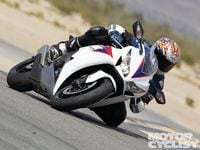
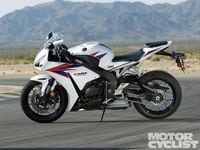
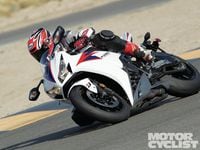

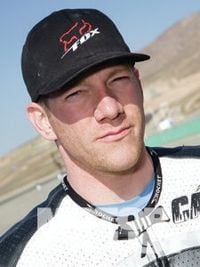
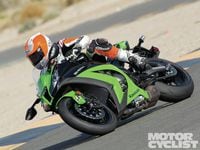

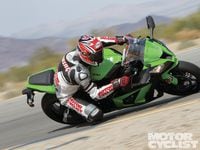
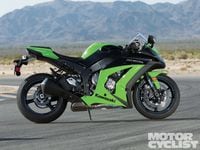
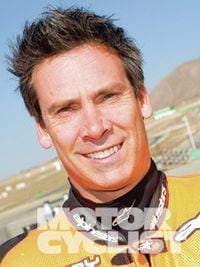
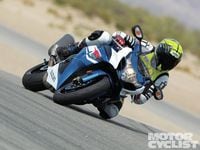
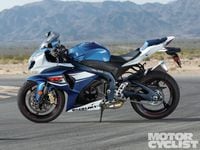

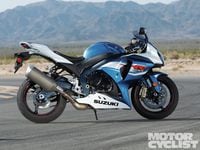

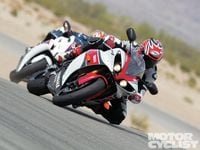
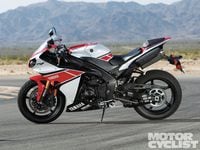
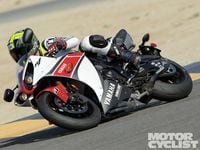

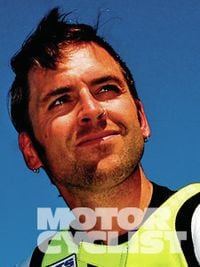

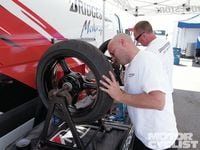

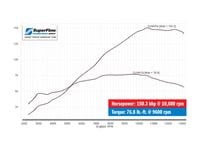
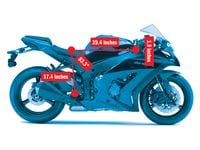
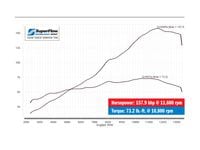


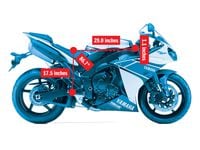
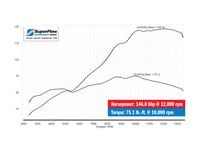
/cloudfront-us-east-1.images.arcpublishing.com/octane/KIX5O23D5NAIBGFXBN3327DKZU.jpg)
/cloudfront-us-east-1.images.arcpublishing.com/octane/7GJYDUIPXRGMTMQKN6ONYOLBOU.jpg)
/cloudfront-us-east-1.images.arcpublishing.com/octane/MUQLOVLL2ZDGFH25ILABNBXKTI.jpg)
/cloudfront-us-east-1.images.arcpublishing.com/octane/TNOU5DNE2BC57MFPMGN2EIDXAM.jpg)
/cloudfront-us-east-1.images.arcpublishing.com/octane/GTCXACQGJ5HAPDTGWUQKDEH44E.jpg)
/cloudfront-us-east-1.images.arcpublishing.com/octane/S35YGSEMEZB4BLTDJTSZPF4GLA.jpg)
/cloudfront-us-east-1.images.arcpublishing.com/octane/5UOT6HPX2JFMRJAX6EH45AR4MQ.jpg)
/cloudfront-us-east-1.images.arcpublishing.com/octane/OKWOJWAKP5EP3OACCRRWPCIX2Q.jpg)
/cloudfront-us-east-1.images.arcpublishing.com/octane/2WF3SCE3NFBQXLDNJM7KMXA45E.jpg)
/cloudfront-us-east-1.images.arcpublishing.com/octane/G4MG6OUCJNBSHIS2MVVOTPX65E.jpg)
/cloudfront-us-east-1.images.arcpublishing.com/octane/IIGGWFOTOJGB7DB6DGBXCCMTDY.jpg)
/cloudfront-us-east-1.images.arcpublishing.com/octane/QSTCM6AVEZA5JJBUXNIQ3DSOF4.jpg)
/cloudfront-us-east-1.images.arcpublishing.com/octane/U4I7G625B5DMLF2DVIJDFZVV6M.jpg)
/cloudfront-us-east-1.images.arcpublishing.com/octane/B6XD6LS6IVCQPIU6HXDJSM3FHY.jpg)
/cloudfront-us-east-1.images.arcpublishing.com/octane/ICL63FEDDRDTTMINYICCEYGMDA.jpg)
/cloudfront-us-east-1.images.arcpublishing.com/octane/FCGZHQXRBZFLBAPC5SDIQLVF4I.jpg)
/cloudfront-us-east-1.images.arcpublishing.com/octane/WNOB6LDOIFFHJKPSVIWDYUGOPM.jpg)

/cloudfront-us-east-1.images.arcpublishing.com/octane/X33NU3E525ECRHXLNUJN2FTRKI.jpg)
/cloudfront-us-east-1.images.arcpublishing.com/octane/6KKT5NNL2JAVBOXMZYS5ZO76YA.jpg)
/cloudfront-us-east-1.images.arcpublishing.com/octane/J5RKG5O455GMPGQRF2OG6LRT7A.jpg)
/cloudfront-us-east-1.images.arcpublishing.com/octane/GX2CIZKQVRH2TATDM26KFG2DAE.jpg)
/cloudfront-us-east-1.images.arcpublishing.com/octane/ZWIDYSAKQZHD5BHREMQILXJCGM.jpg)
/cloudfront-us-east-1.images.arcpublishing.com/octane/CYUHJZCTSJCH3MRAQEIKXK7SCQ.jpg)